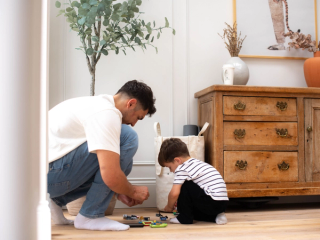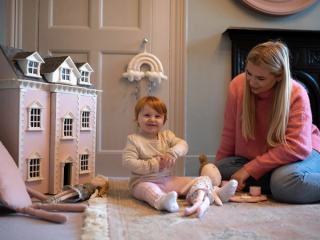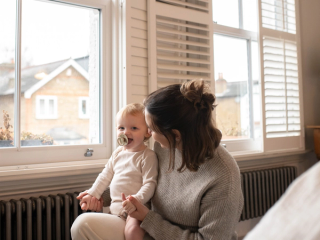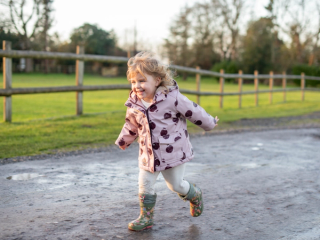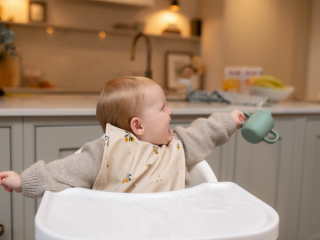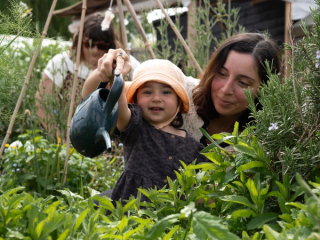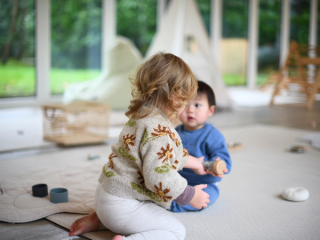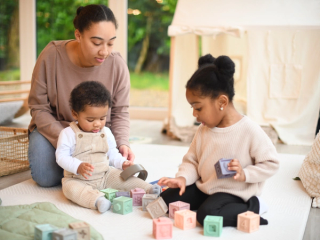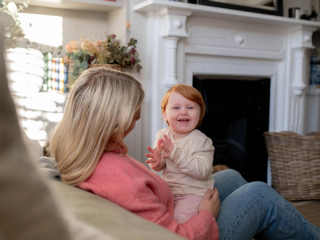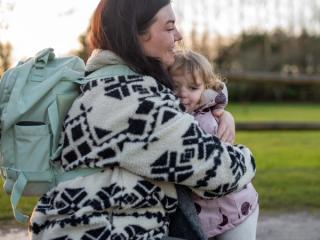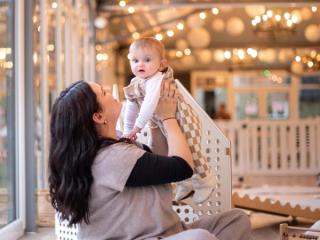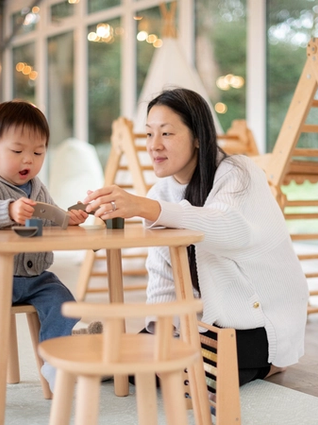
- Home
- Advice Hub
- Toddler
- Toddler Milestones
- Balancing Boundaries
Balancing boundaries: gentle guidance for your growing explorer
Discover how to set loving, effective boundaries for toddlers without power struggles. Explore science-backed strategies from The Behaviour Bank™ to support your child’s emotional growth, confidence, and resilience.
There’s a moment, after the first few steps and sofa surfing and before you even catch your breath, when you realise that life will never be the same again. I mean, this occurrence is not an unfamiliar one as new parents because the chapters of parenthood fly by in a blink of an eye! But, let’s be honest, life with a toddler is a whole new adventure. Their world is growing, and with it comes the enthusiasm and urge to explore, test, climb, and challenge. Alongside this, comes a beautiful burst of independence often comes boundary-pushing.
But here's the truth: toddlers aren't testing boundaries to be “naughty” or a nuisance. They’re testing because they are little scientists learning about their world, about themselves, and about their relationships.
At The Behaviour Bank, through The Behaviour Balance System™ approach, we believe that with the right guidance children (and their grown-ups) can thrive. Let’s explore how you can balance boundaries with freedom in a structured way that supports safety whilst developing confidence and understanding of the world around them. In this article we are going to unpick some wonderful strategies that you can try with your little scientist as you navigate the boundaries together.
Boundaries are loving, not limiting
Firstly, let us address the common misconception that setting boundaries is unkind or strict. We can be empathetic and kind whilst providing supportive boundaries. In fact, boundaries are none of the most important things we can offer our growing explorers.
When boundaries are calm, clear, and consistent, they send powerful messages…
"You are safe."
"I will help you."
"You matter."
Science tells us that the toddler brain is still developing impulse control and understanding consequences. Interestingly, and perhaps surprisingly, this development of impulse control actually continues well into our 20s. Repeated, loving experiences of consistent boundary setting help to literally wire the brain for emotional regulation and decision-making skills that they’ll carry for life.
We can think of boundaries as the frame for our child’s paintings; they give shape and security, but still leave plenty of room for creativity and exploration.
Be clear, creative and consistent
You probably know this already from the number of times you have read that one book or watched that one show, toddlers thrive through repetition. Predictability helps them feel safe in a world that often feels very big and confusing. And as I mentioned, they are like little scientists, they like to find out ‘what happens if…’ and we can support them with this through using simple visuals they can grasp andsimple positive phrases such as;
“Climbing is for the playground. Let’s find a safe place!”
“Food stays on the plate, that’s how we care for our food and our bodies.”
“Gentle hands with people and pets, you can show your kindness.”
When the boundary is tested (because it will be), responding in a calm and consistent way supports children in finding their own internal balance. Every repetition is building brain connections for emotional-regulation. The more they go through the process, the more they learn how.
A quick TBBS reminder:
Consistency isn’t about never making mistakes. It’s about coming back to your core values, again and again, in small ways that build trust. It is ok to be human, in fact it is important to show children that we are human and sometimes find things tough, be kind to yourself in these moments and model that it is ok to make mistakes and move forwards from them.
Turning ‘No’ into ‘Yes’
Ok, before you scroll on or move to the next thing on your ‘to-do list’. I want to start by sharing thatsaying “no” is necessary. This strategy is not about passive parenting, whereby children can just do whatever they like so the adults do not have to say ‘no’. This strategy is about the impact oftoo much “no”, as it can leave children feeling discouraged and frustrated which gets no one anywhere. Surprisingly, toddlers hear the word ‘no’ approximately 400 times per day - which is A LOT! It’s no wonder they learn to say this to us in return. Let’s focus on how we can turn a boundary into an opportunity. Saying ‘yes’ is a way into the brain through the side window. It avoids setting off our children's stress response - their fight, fight, freeze or fawn. We can do this by choosing our words consciously.
It might sound something like this…
“Yes, you want to run! Let’s find a safe place to race.”
“Yes, you love water! Let’s splash in the bath after dinner.”
By acknowledging their need first, you offer connection before redirection which is a core part of the balanced approach we champion in The Behaviour Bank.
Validate feelings, hold the boundary
Boundary-pushing often triggers big emotions,not because your toddler is “defiant,” but because they are still learning how to manage their bodies and all that comes with them. Let’s face it, even adults find this tricky!
When a ‘tantrum’ happens (and it will), it’s an opportunity for connection and emotional growth.
It might sound something like this…
“You’re upset because you wanted to keep playing. That’s hard. I’m here.”
“It’s okay to feel angry. I won’t let you hit mummy when we’re angry. We can stomp the floor together instead.”
A quick TBBS reminder:
Validation doesn’t mean giving in, it means acknowledging the feeling, while calmly upholding the boundary. This supports the development of emotional resilience and secure attachment. Too often we get into power struggles rather than empowering our children through empathy.
Offer micro choices
Toddlers crave autonomy. Yes, back to the power struggles. The more control we have, the safer we feel - big humans and small! But we need to share the control experience with our children, because let’s face it, they have very little control in what they do, where they go, who they see - the list could go on. By offering micro-choices within safe boundaries, you honour their need for independence while maintaining necessary structure.
It might sound something like this…
“Do you want the blue cup or the green one?”
“Would you like to hop or tiptoe to the car?”
These small, manageable choices allow children to practice decision-making and self-regulation, skills that are crucial building blocks for lifelong wellbeing.
Model calm and repair
Part and parcel of being wonderful scientists, children are expert observers. We can witness this in real time on a walk to the local shop after stopping at every tree, sign or blade of grass. So, it is no surprise that they notice all that we do too. The way we handle frustration, stress, and mistakes becomes their template for navigating their own - no pressure! We can set our children up for success through selecting our responses consciously, so try on some of these for size…
“I felt frustrated when the blocks fell. I took a deep breath. Let’s build again!”
“Oops, I got snappy. I’m sorry. Let’s start over.”
Science tells us that when children see us model repair and emotional regulation, their brains register those experiences as learning moments - laying the groundwork for resilience.
Remember, perfection is in the growth. Real, everyday moments of modelling emotional regulation and recovery are more powerful than any grand gesture.
Celebrate the small wins
I cannot share this enough - purely because it is something that most adults find an uphill struggle. Progress often looks like tiny, almost invisible steps. Maybe they paused before throwing. Maybe they only shouted once instead of twice. These are victories so ZOOM IN!
It might sound something like this…
“I saw you stop and think before running. That shows amazing self-control!”
“You asked for help instead of getting upset — what a brilliant choice!”
At The Behaviour Bank™, we offer tools and trackers to help families notice and celebrate these important moments of growth. You are not in this alone.
Balance builds resilience
Family life isn’t about being perfect,it’s about creating an environment where emotional, relational, and behavioural development are nurtured with patience, compassion, and balance. This is how we thrive.
The Behaviour Balance System™ reminds us that growth happens through connection, not correction alone. Through small steps, secure boundaries, and lots of encouragement, our children learn not just how to behave,but how to feel safe, seen, and strong in themselves.
For more practical strategies, scripts, and holistic support, explore The Behaviour Bank™, your trusted companion for building a thriving, balanced family life.
Advice & tips

Want to read more? Join the HiPP BabyClub for full access to this article.
As a BabyClub member, you'll get access to a range of exclusive benefits, including:
Monthly competitions
Discounts from our Partners
Expert advice tailored to your little one's age
Weaning recipes
HiPP shop discounts*
*10% off HiPP's online shop does not apply to our First Infant, Anti-Reflux or Comfort Formula Milk.
Important notice: Breastfeeding is best. Follow on milk should only be used as part of a mixed diet from 6 months. Talk to a healthcare professional.




